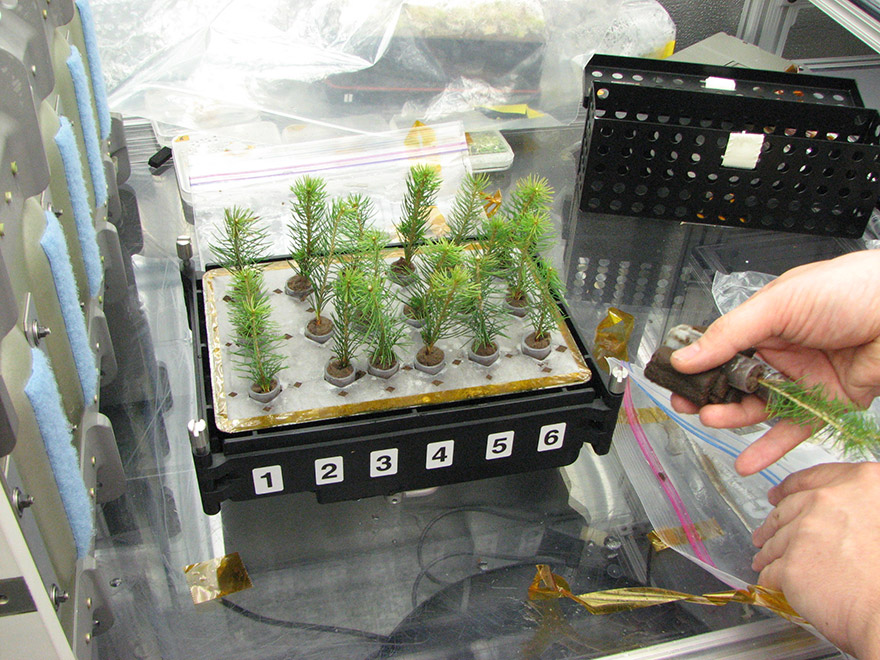Advanced Plant Experiments on Orbit (APEX-CSA2)
APEX-CSA2 uses the International Space Station (ISS) to help Canada's forestry industry.
Updates
- 2010-05-25 - Harvest time!
- 2010-04-19 - The trees are growing!
- 2010-04-08 - White spruce trees transferred from the space shuttle to the ISS

APEX-CSA2 white spruce seedlings being prepared for spaceflight. (Credit: Canadian Space Agency [CSA])
Canada's rich natural resources and reservoir of boreal and temperate forests has helped to ensure our place as the world's largest exporter of forest products. However, in recent years the forestry industry has been challenged by increasing offshore competition, an economic downturn and sustainability issues. To maximize the potential yield of our lumber, Canadian scientists have turned to an unexpected place: space.
Canadian white spruce seedlings were sent to the ISS to help researchers understand how trees make wood. Known as APEX-CSA2 (short for Advanced Plant Experiments on Orbit), the experiment is led by Dr. Jean Beaulieu of Natural Resources Canada's Canadian Wood Fibre Centre in Quebec City, with the close collaboration of the CSA and NASA.
24 white spruce (Picea glauca) seedlings were launched to the ISS aboard the Space Shuttle Discovery on April 5, 2010. On Flight Day 3, 18 of the healthiest seedlings were transferred from the Shuttle to the ISS's Destiny Lab. Expedition 22 crew member T.J. Creamer planted them in a NASA incubator known as the Advanced Biological Research System (or ABRS). The plants grew in space for 30 days, with the incubator controlling the lighting conditions, temperate and atmospheric composition. Researchers on the ground monitored their growth using video cameras, and requested that ISS astronauts water the plants as necessary. Control plants were grown in similar conditions at NASA's Kennedy Space Center for comparison with the space-faring samples.

Space Shuttle Discovery awaiting its launch at the Kennedy Space Center in Florida. (Credit: NASA)
After 30 days of growing in space, the tips of the seedlings' and their roots were clipped and placed in cold storage. They will return to Earth on Space Shuttle mission STS-133 in March 2011. Some of the trees were preserved in formaldehyde to study tissue development (specifically, how the absence of gravity affects tissue composition, organization, plant growth and wood formation). Other plants were selected for genetic analysis using a method developed at Laval University in the context of the Arborea project in partnership with Natural Resources Canada with funding provided by Genome Canada. Beaulieu and his team will compare the genes of plants that grew in space with plants grown under similar conditions on Earth.
APEX-CSA2 follows APEX-Cambium, a University of New Brunswick study led by Professor Rod Savidge that sent willows to the Space Station in November 2009 to study the effects of gravity on "reaction wood" (wood that forms in trees leaning sideways, which is good for pulp and paper, but not lumber). Both experiments are expected to reveal clues about gravity's role in the formation of tree cells.
Studying the genetics of plant growth on the International Space Station can also lead to biotechnology applications in the field of forestry and agriculture. One of the challenges facing the forestry sector is balancing the increasing demand for wood fibre with the need to manage forest ecosystems in a sustainable way for present and future generations of Canadians. By better understanding the genetics of white spruce - an economically important species widely used in the pulp and paper industry - it may one day be possible to select and design genetically improved varieties that would allow them to cope with climate change, for example, with the fibre attributes that would allow the Canadian forest industry to be more competitive.